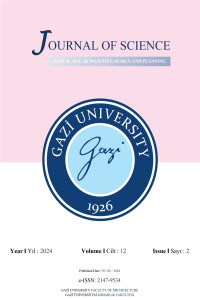Öz
Kaynakça
- [1] Henggeler Antunes, C. (2014). Energy efficiency for a more sustainable World, Energy Policy, 67, 1-3. doi:10.1016/j.enpol.2014.01.001
- [2] Geske, J. (2022). The value of energy efficiency in residential buildings – a matter of heterogeneity?!, Energy Economics, 113. doi: 10.1016/j.eneco.2022.106173
- [3] URL-1. International Energy Agency [IEA], Key World Energy Statistics 2021. https://iea.blob.core.windows.net/assets/52f66a88-0b63-4ad2-94a59d36e864b82 / KeyWorld Energy Statistics2021. pdf. Last Accessed: 25.04.2023.
- [4] URL-2. Union of Chambers of Turkish Engineers and Architects, Dünyada ve Türkiye’de Enerji Verimliliği.https://www.mmo.org.tr/sites/default/files/gonderi_dosya_ekleri/a551829d50f1400_ek_0.pdf. Last Accessed: 05.07.2022.
- [5] Aydın, Ö.,(2019). Binalarda Enerji Verimliliği Kapsamında Yapılan Projelerin Değerlendirilmesi: Türkiye Örneği, Mimarlık ve Yaşam , 4(1), 55-68. doi: 10.26835/my.511825
- [6] URL-3. American Society of Heating, Refrigerating and Air-Conditioning Engineers [ASHRAE] Standard 55 (2020), Thermal Enviromental Conditions for Human Occupancy. https://www.ashrae.org/technical-resources/bookstore/standard-55-thermal-environmental-conditio ns- for-human-occupancy. Last Accessed: 12.04.2023
- [7] URL-4. Turkish Standards Institution [TSE] (2013). Turkish Thermal Insulation Standard. https://intweb.tse.org.tr/Standard/Standard/Standard.aspx. Last Accessed: 10.06.2022.
- [8] Paschoalin, R., & Isaacs, N. (2021). Applying International Guidelines on Historic Building’s Retrofit in New Zealand: A Critical Context View. Heritage, 4(4), 3697-3711.
- [9] ASHRAE (2022), Preserving Historic Buildings, Saving Energy, https://ashrae.org/. Last Accessed: 07.07.2022.
- [10] URL-5. Ministry of Environment and Urbanization (2008). Energy Performance Regulation in Buildings. https://www.resmigazete.gov.tr/eskiler/2008/12/20081205-9.htm. Last Accessed: 07.07.2022.
Evaluation of Thermal Performance of Traditional Houses and Suggestions for Improvement: Case of Beypazarı Mehmet Üsdün House
Öz
Traditional buildings should be studied to increase their thermal performance in order to preserve cultural heritage for future generations and ensure proper functionality. This study presents a model proposal for simulating the thermal performance of traditional houses using DesignBuilder software. The results of this evaluation will be used to create suggestions for improving historical buildings. It is possible to evaluate the thermal performance of traditional houses with current analysis software and make suggestions for improving their capacity through preservation activities. Firstly, data were collected, and standards and simulation tools related to thermal performance were examined. A traditional house was chosen as a case study for creating a proposal model and conducting thermal analysis. In the second step, the data processing stage was performed, and the house model was created in DesignBuilder. The collected data were entered into DesignBuilder and simulated. The simulation results were compared with the Turkish Standards (TS 825 - Thermal insulation requirements for buildings). Finally, suggestions were presented as proposals and solutions to improve the thermal performance of historical buildings based on the findings of this study. As a result of this study, it was found that implementing underfloor heating systems in Mehmet Üsdün House increased the thermal performance of the house by 30-35%. It can be concluded that the thermal performance of historical buildings can be effectively improved through the proper utilization of these buildings.
Anahtar Kelimeler
Thermal performance Traditional buildings Simulation Designbuilder Beypazarı
Kaynakça
- [1] Henggeler Antunes, C. (2014). Energy efficiency for a more sustainable World, Energy Policy, 67, 1-3. doi:10.1016/j.enpol.2014.01.001
- [2] Geske, J. (2022). The value of energy efficiency in residential buildings – a matter of heterogeneity?!, Energy Economics, 113. doi: 10.1016/j.eneco.2022.106173
- [3] URL-1. International Energy Agency [IEA], Key World Energy Statistics 2021. https://iea.blob.core.windows.net/assets/52f66a88-0b63-4ad2-94a59d36e864b82 / KeyWorld Energy Statistics2021. pdf. Last Accessed: 25.04.2023.
- [4] URL-2. Union of Chambers of Turkish Engineers and Architects, Dünyada ve Türkiye’de Enerji Verimliliği.https://www.mmo.org.tr/sites/default/files/gonderi_dosya_ekleri/a551829d50f1400_ek_0.pdf. Last Accessed: 05.07.2022.
- [5] Aydın, Ö.,(2019). Binalarda Enerji Verimliliği Kapsamında Yapılan Projelerin Değerlendirilmesi: Türkiye Örneği, Mimarlık ve Yaşam , 4(1), 55-68. doi: 10.26835/my.511825
- [6] URL-3. American Society of Heating, Refrigerating and Air-Conditioning Engineers [ASHRAE] Standard 55 (2020), Thermal Enviromental Conditions for Human Occupancy. https://www.ashrae.org/technical-resources/bookstore/standard-55-thermal-environmental-conditio ns- for-human-occupancy. Last Accessed: 12.04.2023
- [7] URL-4. Turkish Standards Institution [TSE] (2013). Turkish Thermal Insulation Standard. https://intweb.tse.org.tr/Standard/Standard/Standard.aspx. Last Accessed: 10.06.2022.
- [8] Paschoalin, R., & Isaacs, N. (2021). Applying International Guidelines on Historic Building’s Retrofit in New Zealand: A Critical Context View. Heritage, 4(4), 3697-3711.
- [9] ASHRAE (2022), Preserving Historic Buildings, Saving Energy, https://ashrae.org/. Last Accessed: 07.07.2022.
- [10] URL-5. Ministry of Environment and Urbanization (2008). Energy Performance Regulation in Buildings. https://www.resmigazete.gov.tr/eskiler/2008/12/20081205-9.htm. Last Accessed: 07.07.2022.
Ayrıntılar
| Birincil Dil | İngilizce |
|---|---|
| Konular | Mimari Miras ve Koruma, Sürdürülebilir Mimari |
| Bölüm | Mimarlık |
| Yazarlar | |
| Yayımlanma Tarihi | 30 Haziran 2024 |
| Gönderilme Tarihi | 17 Nisan 2024 |
| Kabul Tarihi | 26 Mayıs 2024 |
| Yayımlandığı Sayı | Yıl 2024 Cilt: 12 Sayı: 2 |


